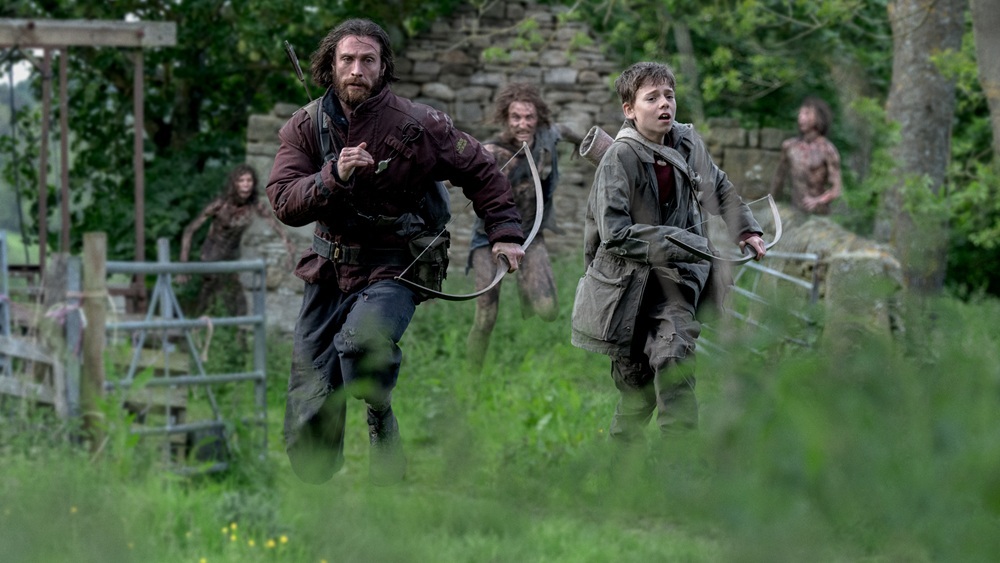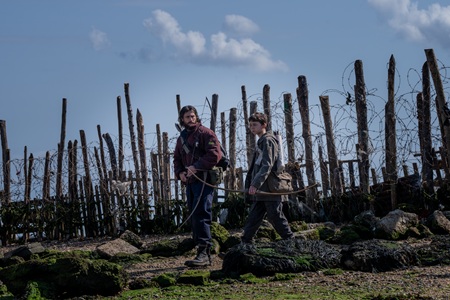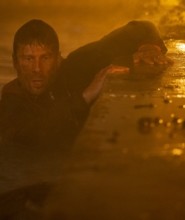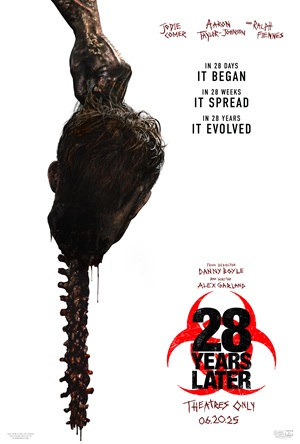
Boyle and Garland Return to a Viral Dystopian Nightmare with 28 Years Later
It’s been 28 years since the Rage Virus was released from a London laboratory. While infections have been eradicated from the European mainland, the United Kingdom is a different matter altogether. The islands are a massive quarantine zone continually patrolled by an international armada to ensure no one, no matter what their infection status, ever makes it out. No one leaves. Never. That’s the only way the virus can remain contained.
A small township has managed to survive virtually intact throughout the crisis. They are surrounded by water, their lone connection to the remainder of the U.K. a small land bridge that is only passable during low tide. Hunters and loggers go across to collect the necessary items that help keep their community alive. Other than that, everyone stays put behind the protection of their solid wooden walls.
For youngsters entering their teenage years, it is also a rite of passage to head into the forests beyond the sea to learn how to kill the infected. Most come back to a rowdy homecoming. Some, sadly, do not, and their passing is mourned by everyone in silence.
With 28 Years Later, director Danny Boyle and writer Alex Garland return to the undead netherworld they created with 2002’s instant classic 28 Days Later. Thankfully, neither of them was content to sit on their laurels. While I did not know what to expect from this sequel, it certainly wasn’t a coming-of-age, Ken Loach-style tragedy of rebirth, death, guilt, regret, communication, religious fundamentalism, and love. Boyle and Garland have delivered a dour, bleakly demolishing descent into darkness where optimism and courage are in short supply, and the parallels between their dystopian nightmare and our march toward fascist-fueled Armageddon are chillingly undeniable.
Yet, amidst all this madness, the pair also find hope. In the remembrance of the lives lost, infected and uninfected alike, even in a land overflowing with hardship, brutality, and pain, a path towards reclaiming one’s lost humanity and finding the nerve to build something better anew still exists. A light does shine at the end of the tunnel. Whether this will be bright enough to bring on a new dawn of tolerance, acceptance, and freedom is anyone’s guess; the potential that it will be is a battle worth fighting.
The narrative structure is split into three distinct parts. In the first, devoted father Jamie (Aaron Taylor-Johnson) takes his 12-year-old son Spike (talented newcomer Alfie Williams) across the land bridge to conduct his first hunt. In the second, Spike leads his ill mother Isla (Jodie Comer) out of town and into the unknown searching for someone who can cure what ails her. Finally, in the third, the two encounter Dr. Kelson (Ralph Fiennes), a mysterious man who has learned to uneasily live alongside the infected and likely knows more about the Rage Virus than anyone else on the planet.
Interspersed amongst all of this are a pair of subplots: a brief, ultra-violent prologue reminding the viewer of what happened during the first few days of the Rage Virus’ release into the world, and then another later on following a small group of Norwegian soldiers who get stranded in the U.K. after their ship meets with an accident. These are both vitally important to Spike’s eye-opening journey. Each in their own way grants him unexpected insight into all that was lost before he was even born along with everything that could possibly be gained if humanity would learn from its past mistakes and move forward into a new tomorrow without falling to temptation or fear.
It’s messy stuff, and Boyle and Garland can’t make it all cleanly connect. But I think much of that is by design. There is a disquieting discombobulation to Spike’s story that keeps him, and by extension the audience, continually uneasy. He’s too young to fully comprehend what happened to the world, and his parents are too protective to have filled him in as much as maybe they should have. This is what has led him to leave the protections of their home and take his mother on this dangerous quest to Dr. Kelson, and it is this search for the truth that will change the course of his young life going forward.
Comer is phenomenal. She gives a multifaceted, deeply scarred performance that traverses a thin line separating sanity from insanity. Isla’s illness has her battling moments where all rational concepts of time and place abandon her completely, only for coherence and mental acuity to return with abrupt, almost vicious suddenness seconds later. Comer’s physical magnificence is matched by her emotional ingenuity, everything building to a moment of selfless maternal affection that had me wiping away one authentic tear after another.
On a technical front, Boyle reunites with frequent collaborators director of photography Anthony Dod Mantle and editor Jon Harris, the former of whom as essential to the success of 28 Days Later as either the director or writer were. Together, this trio creates a visual maelstrom of unhinged handheld poetry. It’s gorgeous. It’s abhorrent. Most of all, the world they create is multidimensional, suitably dingy, and lived-in, showcasing a hardscrabble expressiveness that left me breathless. The kinetic, hyperviolent grace of it all is spellbinding, as is the downtrodden, blood-covered monotony.
I haven’t spoken about any of the core twists and turns, and this includes how the infected have survived for almost two decades, and I have no intention of doing so. What I will say is that there is a profoundly grim eloquence to what Boyle and Garland are attempting to communicate throughout all this unrelentingly nihilistic terror that lingered in my soul like a cancerous growth long after the film concluded. This isn’t so much a continuation of the story the pair began back in 2002 as it is a necessary storytelling evolution that goes in new directions and asks even tougher questions.
Those expecting the familiar status quo of what came before or the comfort of something akin to “Faster, Zombies! Kill! Kill!” will undoubtedly be disappointed. As will those who want everything to be wrapped up in tidy ribbons and simplistic resolutions. But even with a gonzo cliffhanger of an ending (a follow-up, 28 Years Later: The Bone Temple, is scheduled to be released in 2026, and another after that is reportedly in the works as well), my hope is that audiences will embrace this sequel for the exhilarating, risk-taking downer that it is.
Boyle and Garland refuse to play it safe and, by doing so, make 28 Years Later an essential piece of horror social commentary. This is one of the year’s best films.
– Review reprinted courtesy of the SGN in Seattle
Film Rating: 3½ (out of 4)







